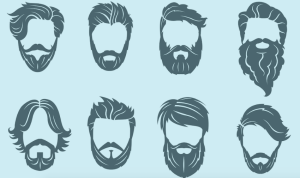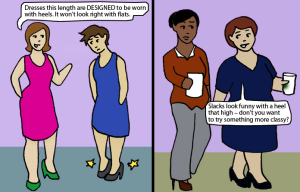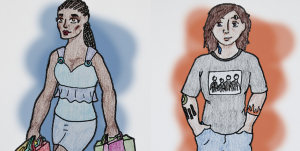Every few weeks, somebody in my Facebook feed is bound to post a “Share If You Agree” meme about welfare.
They usually say something about how people who use drugs don’t deserve welfare or that users should be able to pay for their own food if they can afford a cell phone.
And every time I see these posts, I’m infuriated. Because these assumptions about welfare users are based on a false stereotypes about who uses welfare programs, why they need them, and who deserves access to social safety net programs – assumptions based on stereotypes that are only meant to stigmatize these programs and those in poverty.
When you picture the average person using public benefits programs like welfare, social security, and food stamps, who comes to mind?
As evidenced by the endless posts on social media on the topic, for many of us, the common assumptions about who uses welfare and why doesn’t match up with reality.
Media and conservatives paint the average welfare user as everything but responsible, hard-working people struggling to get by day-to-day, or the disabled and elderly who need these programs to get by.
Instead, they tell us they are “moochers.”
Recipients are stereotyped as being mostly single moms and black folks, and more often than not, politicians and other pundits insinuate (and sometimes directly claim) that using these programs is criminal.
We’re told that those who use the programs are wasting the money of hard-working taxpayers around the country – that they don’t want jobs because they’re lazy or just looking for the easy way out. We hear that those who need these programs are doing nothing more than trying to scam others out of their tax dollars and defraud the government.
And these stereotypes have serious repercussions.
When popular media and opinion paint the average welfare users as people of color trying to game the system, it reinforces the criminalization and stigmatization of those folks, further marginalizes oppressed groups, and erases the immensely varied experiences of all of those who need welfare programs.
Not to mention that we know these stereotypes aren’t true. In fact, most welfare users actually just can’t make ends meet in a system stacked against them.
So why is the popular image of the average welfare user so divorced from reality?
Let’s start with how these myths and stereotypes got their start:
‘Welfare Queens’ and ‘Blissfully Jobless Surfers’ – Tracing Back the Myth
Welfare is as old as the US government itself, dating all the way back to when the colonies had programs to help the poor and disabled based off of the British Poor Laws, but it wasn’t until the Great Depression that the safety net programs we’re now accustomed to were first put in place.
With so many out of work, Franklin D. Roosevelt signed the Social Security Act of 1935 establishing several government programs to help ease the burden Americans were facing.
But by the 1970’s, Ronald Reagan launched a full-on attack on these vital programs in his stump speeches.
Using an anecdote based on Linda Taylor, a woman who had defrauded the government out of hundreds of thousands of dollars through a series of elaborate measures, Reagan crafted the myth of the “welfare queen” in order to stigmatize the program and make it easier to get rid of.
When Reagan told Taylor’s story during a campaign speech, he said that “She used eighty names, thirty addresses, fifteen telephone numbers to collect food stamps, Social Security, veterans’ benefits for four nonexistent deceased veteran husbands, as well as welfare. Her tax-free cash income alone has been running $150,000 a year.”
And that was all it took.
From that point on, the stereotype of the welfare user being a black woman doing everything she could to take advantage of the system – and being better off than the average person while doing so – was forever in the public consciousness.
As Kaaryn Gustafson explained to CNN, the story of the welfare queen become a major trope from that point on.
“This image of the lazy African-American woman who refuses to get a job and keeps having kids is pretty enduring. It’s always been a good way to distract the public from any meaningful conversations about poverty and inequality,” explained Gustafson.
The truth behind Taylor’s story is seemingly still up for debate – but the end result was clear: The welfare queen was born.
This stereotype has remained in the public eye ever since.
As Anna Gibson explained in For Harriet, “The archetype of the shiftless, lazy Black woman, jobless and trailing five unkempt children in her wake is the perception that the media widely uses to cast all Black women as perpetual vampires of taxpayer dollars. Black women on public assistance supposedly steal money from taxpayers and do not contribute anything to society.”
And this myth is perpetuated by the racist, classist, and sexist structures it relies on.
There are also ideas of Black women “gaming the system” by being lazy, and unable to find a job because they don’t try hard enough.
The issue here is ultimately structural. Women in impoverished communities, especially if they grew up there, lack access to educational opportunities.
Due to gentrification and red lining, we find that a number of Black welfare recipients are unable to access the resources that will both revitalize a community and help them retain the job skills necessary to completely move out of a cycle of poverty,” wrote Gibson.
Fast-forward to the new millennium and we find a media environment that has truly run with the concept.
Take Fox News for example.
During my day job at Media Matters, we encounter the ramifications of Reagan’s welfare queen myth everyday in the form of consistent efforts to demonize and shame the poor. Fox hosts have even gone as far as to call for more stigma around those who use these programs.
Yesteryear’s “welfare queen” has now been joined by today’s “blissfully jobless surfer” – Fox News’ token example of the modern-day “welfare abuser.”
During a 2013 special on how the United States has become the “Entitlement Nation,” the network debuted Jason Greenslate, an unemployed surfer fraudulently using food assistance programs in order to eat luxurious foods like lobster.
Green became the poster-boy modern welfare abuse, and has been trotted out by the network as an example of how the average entitlement program user utilizes their benefits.
Where the “welfare queen” helped enforce a false notion that poor black women were conspiring to game the system, the “jobless surfer” exists to help shift popular opinion to believe that welfare users aren’t using their benefits just to get by.
It posits that recipients are instead just trying to abuse programs to live luxuriously in a way that is out of reach for the average American.
The Average Welfare User Isn’t Who You Might Imagine
Contrary to popular belief, the jobless surfer and the welfare queen are not the real faces of welfare. In fact, the truth is almost exactly the opposite.
Would you be surprised if I told you the majority were white? How about if I told you many welfare users actually have jobs?
As Danica Johnson explained for Everyday Feminism, “[M]ost welfare programs require recipients to work in order to collect.”
Programs like Temporary Assistance for Needy Families (TANF) require single parents to work at least thirty hours per week, and a recent study by the Census bureau found that in 2012, 6.7% of the full-time workforce and 17.6% of the part-time workforce used government benefit programs.
So it isn’t that welfare users aren’t working – it’s that their paychecks don’t offer a living wage.
“The fact is, blue-collar wages in America are simply not high enough to support workers in today’s economy. The wages paid by many large employers (including giants like Wal-Mart) are so low that their full-time employees are eligible for welfare,” explained Johnson.
And welfare users aren’t trying to game the system either.
Fraud in programs like SNAP (or food stamps) is incredibly low – according to the US Department of Agriculture, the percentage of fraud has gone down dramatically “from about four cents on the dollar in 1993, to about one cent in 2006-08.”
Welfare queens living large off the taxpayer’s dollar are no more than a myth. In truth, even with public benefits many families are still struggling to get by.
Those enrolled in government programs have less money to spend on necessities like food, clothing, and housing than the average American, devoting a whopping 77% of their total income to it compared to the national average of 65%.
And if you’re using food assistance programs, you’ll have less than $1.40 to spend per meal – that probably won’t get you the filet mignon or lobster Fox News keeps saying you can afford.
Yet Myths and Stereotypes About Welfare Users Persist – With Dangerous Consequences
The end result of Reagan’s championing of the “welfare queen” and Fox News’ insistence that those who use government programs are just freeloading has been to load welfare programs and the people who use them with stigma.
Trying to rollback the programs themselves, conservatives have put forth a concerted effort to stigmatize and shame the poor in order to discourage them from using benefits they’re entitled to and justify cutting the social safety net programs so many need just to get by.
Although legislators say their cuts and restrictions are meant to address rampant fraud in the system and help people get jobs, we know this doesn’t match-up with the realities of how people use these programs.
That has left Americans with countless pieces of ridiculous legislation centered around the baseless myths that welfare users are lazy and trying to game the system.
Take Kansas for example.
Earlier this year the state introduced a measure to ban welfare users from using their benefits at spas, tattoo parlors, and psychics. Republicans claimed that the bill would address fraud in the state, but it had just one problem: This wasn’t how people were using their benefits to begin with.
Shannon Cotsoradis, CEO of Kansas Action Children, explained to CNN that the measure “vilifies and mischaracterizes the typical” family using welfare programs in the state.
She noted that welfare users in Kansas were largely single-parent households with two children, and that the state’s program only offered them an average of $400 a month – far less than what these families need to survive.
***
Let’s be clear: Stereotypes about welfare users exist so that those privileged enough not to need these programs won’t second guess it when they’re taken away.
But it is imperative not to buy into them – because the sad reality resulting from these decidedly false stereotypes and assumptions presuming those who use welfare are just trying to defraud the system is a legislative landscape full of ridiculous legislation meant to address non-existent problems.
Social safety net welfare programs provides keep millions out of poverty each year. They help feed millions of children. They protect the elderly and the disabled.
And that means not fact-checking the myths behind their stigmatization is down-right dangerous for those who rely on these programs to keep themselves and their families safe and healthy.
We can’t continue to let the perpetuation of these myths slide, because the reality is that the average welfare user is all of us.
The stigmatization around welfare programs leads many to believe that it could never happen to them; that they would never need these programs because the people who do just aren’t working hard enough.
But studies have found that four out of five adults in the US “struggle with joblessness, near-poverty or reliance on welfare for at least parts of their lives,” and 55% of Americans have used a public benefit program at some point in their lives.
So next time you think of the average welfare user, don’t be so quick to assume they’re a “welfare queen” or the “blissful surfer” – because in reality, they probably look a lot more like you.
[do_widget id=’text-101′]
Ally Boguhn is a Contributing Writer for Everyday Feminism and a feminist activist and media researcher living and working in Washington, DC. She completed both her B.A. in Communications and Art History as well as her M.S. in Professional Communications at Clark University, where she researched abortion debate rhetoric. Ally is also the founder and editor of Because I am a Woman, a blog devoted to intersectional feminism and reproductive justice. You can follow Ally on Twitter @AllyBoguhn. Read her articles.
Search our 3000+ articles!
Read our articles about:
Our online racial justice training
Used by hundreds of universities, non-profits, and businesses.
Click to learn more





















